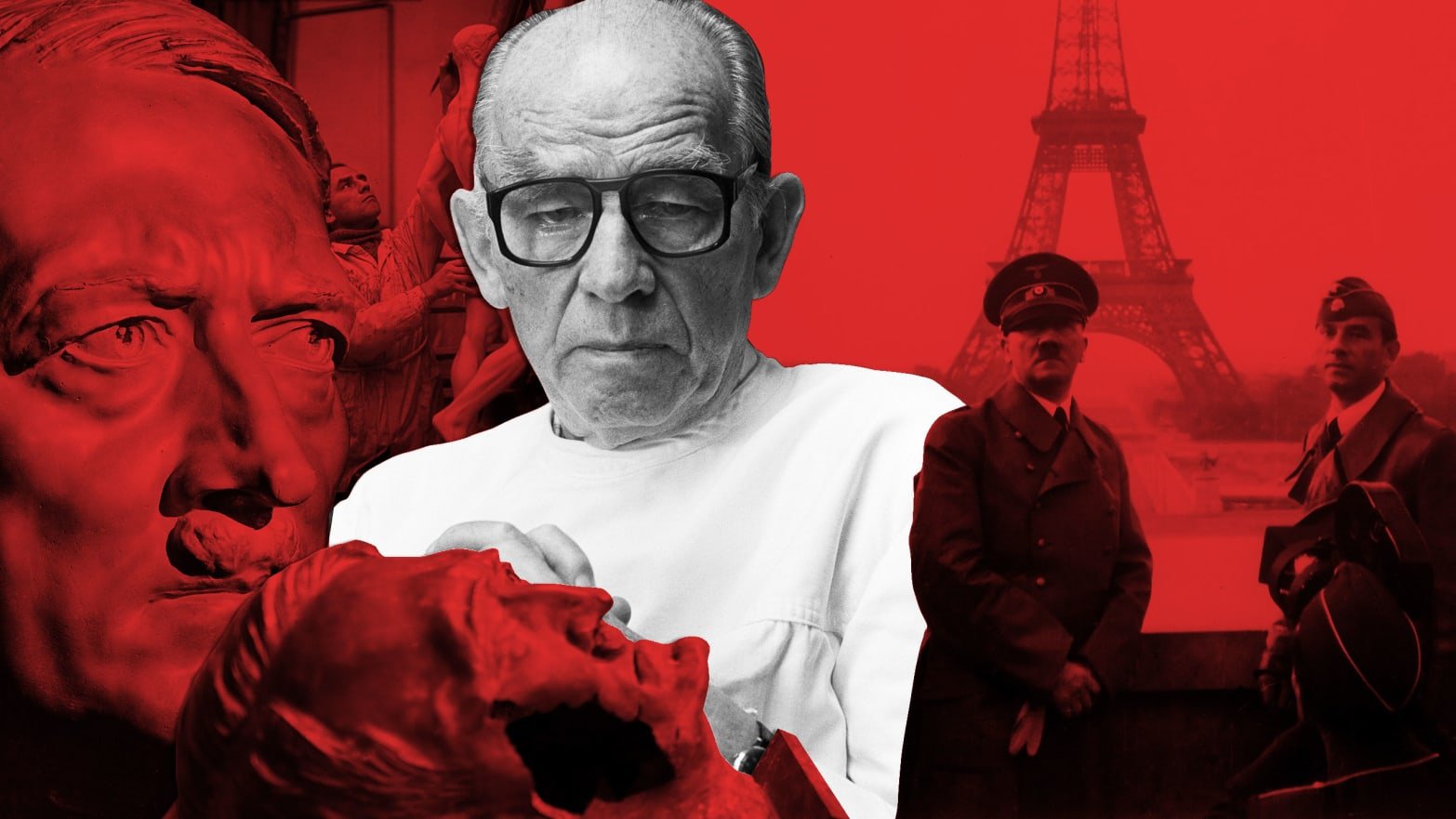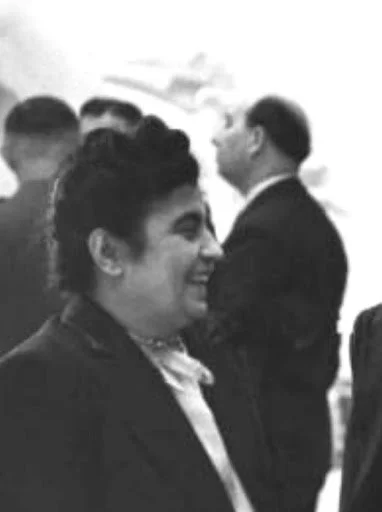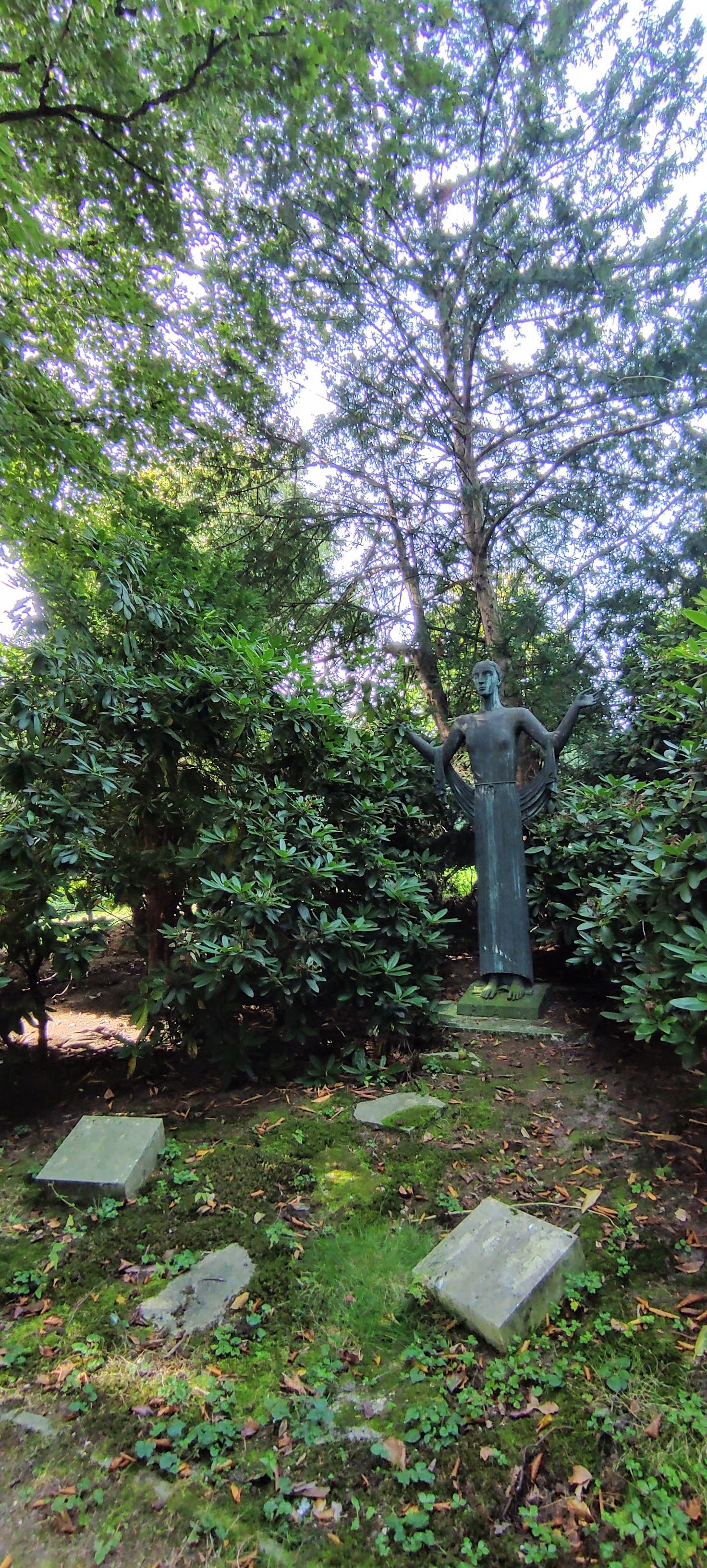
Arno Breker
Hitler’s Sculptor
“God is beauty and Arno Breker is his Prophet.”
Salvador Dali, 1975.
”The Michelangelo of the Third Reich”
Arno Breker (1900 – 1991) was a German sculptor, best known for his public works in Nazi Germany, which were endorsed by the authorities as the antithesis of degenerate art. During his time in Paris in the twenties and early thirties he was influenced by Jean Cocteau, Jean Renoir, Pablo Picasso and Aristide Maillol. He maintained personal relationships with Albert Speer and with Hitler.
In 1936 he won the commission for two sculptures representing athletic prowess, to be entered in the 1936 Olympic games arts competition in Berlin, one representing a Decathlete ("Zehnkämpfer"), which won the silver medal for statues, and the other The Victress ("Die Siegerin"). In 1937 he married Demetra Messala (Δήμητρα Μεσσάλα), a Greek model. The same year, Breker joined the Nazi Party and was made "official state sculptor" by Hitler.
Albert Speer, Adolf Hilter and Arno Breker visiting Paris after the Occupation.
Breker was commissioned to make two sculptures representing athletic prowess, to be entered in the 1936 Olympic games arts competition in Berlin, one representing a Decathlete ("Zehnkämpfer"), which won the silver medal for statues, and the other The Victress ("Die Siegerin").
In 1937 Breker joined the Nazi Party and was made ‘official state sculptor’ by Hitler. He was given a large property and provided a studio with forty-three assistants. As main sculptor and more or less number one on the Gottbegnadeten list (devinly gifted), he was exempted from military service. His twin sculptures The Party and The Army held a prominent position at the entrance to Albert Speer’s New Reich Chancellery.
The Party and The Army Sculptures outside the Reich chancellery 1942
Before gaining the affection of Hitler, however, Breker had to undergo adversities, as it was difficult for him to gain a foothold in the Reich’s capital city under the new conditions which existed there. After 7 years abroad, Breker was called “the Frenchman” and was looked down as non-meritory. Adversities included paradoxes such as being accused by Alfred Rosenberg (the editor of the Nazi newspaper Völkischer Beobachter) of being a degenerate artist (!), or his wife Demetra being suspected of being Jewish (!). Despite these handicaps, because Demetra Messala had by then become a succesful international art dealer and because she belonged to a Greek well-to-do family, the couple had little financial concerns.
From 1936 onwards, the situation improved as Breker and Messala began to enjoy the privileges of being affiliates of top Nazi leaders. Breker was appointed professor of sculpture at the College for Educational Arts in Berlin, and the couple lived comfortably in a large house 75 km East of Berlin. They attended the most exclusive events in Nazi Germany, and were seen in intimate company of Hitler at his private parties in a number of occasions, including at Hitler’s hideout in Berchtesgaden.
However, things would be slighlty different after the Nazi defeat in 1945. After the German downfall, the Americans identified Arno and Demetra, but were not prosecuted heavily. They only intended to let the denazification board examine thier record and determine their fate. The Americans merely kept an eye on them and helped them move north to the town of Wemding near Nördlingen in October 1945. They were given a thirteen-room house, a luxury at a time when space was extremely precious. Demetra Messala was also able to purcahse an automobile, a really prized object in Allied-occupied Germany. Later on, in a June 1946 letter, Messala would defend the acquisition as being “for the procurement of materials, like plaster, clay, stone samples, and tools”.
In any case, in an area flooded with homeless refugees, Arno and Demetra enjoyed privileged provisions, and in fact Breker’s work was mostly not interrupted through the culmination of the war and the ensuing persecution of former Nazi hardliners.
Demetra Messala would die in a car accident in 1956, but her husband would not die until 1991, at age 91. Despite being stigmatized for his public works in the Nazi regime, he never stopped getting work requests. In 1978, Breker was elected by the Greek government to produce a 10-meters tall sculpture of Alexander the Great, intended to be located in Greece, the country that inspired his art.
Re: Arno Breker's wife Quote #7
Post by Helge » 11 May 2014, 18:14
(Axis History Forum,1999)
Demetra Messala and Arno Brecker
Demetra Messala
Arno Brecker, with his second wife, Charlotte Kluge, and her children, Gerhard (21 years) and Carola (18 years).
While nearly all of his sculptures survived World War II, more than 90% of his public work was destroyed by the Allies after the war. In 1946 Breker was offered a commission by Joseph Stalin but he refused and stated ‘One dictatorship is sufficient for me’.
After the war he continued to receive commissions for sculptures, producing a number of works in his familiar classical style, working for businesses and individual patrons. He also produced many bronze female sculptures, in smaller sizes. Some of these were casts from original models designed before 1945. His works can be seen in the Breker Museum in Schloss Nörvenich in Germany.
Arno Breker was represented at the Great German Art Exhibitions with 42 works. The neoclassical nature of his work, with titles like ‘Comradschip’, ‘Torchbearer’ and ‘Sacrifice’, typified Nazi ideals, and suited the characteristics of Nazi architecture. On closer inspection, though, the proportions of his figures, the highly colorful treatment of his surfaces (the strong contrasts between dark and light accents), and the melodramatic tension of their musculatures perhaps invites comparison with the Italian Mannerist sculptors of the 16th century.
Four works by Breker were part of the art collection of Hermann Göring and destinated for the ‘Norddeutsche Gallery’ ( Herman Goering’s Gallery -The Norddeutsche Gallery was to be erected as an annex to Karinhall in the big forest of the Schorfheide, near Berlin).
An original marble relief ‘Du und Ich’, as well as three bronze life size sculptures by Breker, were displayed at the exhibition ‘Nazi Design’, Design Museum Den Bosch, The Netherlands, 8 September 2019 – 1 March 2020. This world-wide highly publicized exhibition attracted over 130.000 visitors in six months. The exhibition was covered on the front page of the New York Times and Bild, and i.a. in the Guardian, Le Monde, Le Figaro, Paris Match, Spiegel, Welt, Tagesspiegel, El Pais and all Dutch News papers. On television the exposition was covered i.a. by the ARD, ZDF, DW News, Aljazeera, AFP News Agency, SBS World News, and all mayor television chanels in The Netherlands. Because of the enormous popularity of the exhibition, the museum extended opening hours, opened its doors also on Mondays, and finally it extended the exhibition by 6 weeks.
Albert Speer posing for his sculpture
Sculptures 1935–1945
Die Partei, Breker's statue "Die Partei", representing the spirit of the Nazi Party that flanked one side of the carriage entrance to Albert Speer's new Reich Chancellery.
Prometheus (1935)
Relief am Gebäude der Lebensversicherung Nordstern, Berlin (1936)
Der Zehnkämpfer fürs Olympia-Stadion, Berlin (1936, Silver medal)
Die Siegerin fürs Olympia-Stadion, Berlin (1936)
Dionysos fürs Olympia-Dorf, Berlin (1936)
Der Verwundete (1938)
Der Rosseführer (1938)
Anmut (1938)
Fackelträger („Die Partei") im Hof der Neuen Reichskanzlei (1939)
Schwertträger („Die Wehrmacht") im Hof der Neuen Reichskanzlei (1939)
Schreitende Pferde, Gartenfront, Neue Reichskanzlei (1939)
Der Künder (1939)
Der Wäger (1939)
Bereitschaft (1939)
Der Rächer (1940)
Kameraden (1940), Breker-Museum
Bannerträger (1940)
Abschied (1940)
Vernichtung (1940)
Opfer (1940)
Schreitende (1940)
Der Wächter (1941)
Psyche (1941)
Berufung (1941)
Der Sieger (1942)
Kniende (1942)
Eos (1942)
Flora (1943)
Heros (1943)
Arno Breker Sculptures, a video journey.
The Decathlon and the Victress - Berlin Olympic park April 2024
Arno Breker
Born 19 July 1900
Elberfeld,
Kingdom of Prussia,
German Empire.
Died 13 February 1991 (aged 90)
Düsseldorf, Germany.
Arno Breker’s Grave and Memorial
















